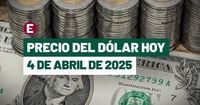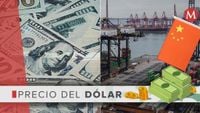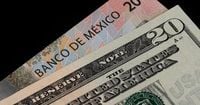On April 4, 2025, the Mexican peso experienced a significant depreciation against the U.S. dollar, reaching a peak exchange rate of 20.55 pesos per dollar. The dollar's price was around 20.51 pesos, reflecting a 2.92% drop in the peso, equivalent to a loss of 58 centavos. This marked the worst decline for the peso since June of the previous year, following the presidential elections, according to Gabriela Siller Pagaza, director of analysis at Banco Base.
During the trading session, the exchange rate fluctuated between a maximum of 20.5575 pesos and a minimum of 19.9056 pesos after opening at 19.9110 pesos. The depreciation of the peso was attributed to heightened risk aversion amid fears of a potential global recession, primarily driven by the tariff policies implemented by U.S. President Donald Trump. These policies have raised concerns about a renewed trade war between the world’s two largest economies, the United States and China.
As part of the fallout from these tariffs, China has responded by adding 11 U.S. companies to its list of unreliable entities and has restricted the export of various minerals and chemicals. This move has further escalated tensions in international trade and contributed to the decline of the peso.
In terms of specific exchange rates at various banks across Mexico on April 4, 2025, Banco Afirme was buying at 19.40 pesos and selling at 21.00 pesos, while Banco Azteca was buying at 19.25 pesos and selling at 20.85 pesos. Banorte offered a buying rate of 19.35 pesos and a selling rate of 20.85 pesos. BBVA Bancomer had a buying rate of 19.61 pesos and a selling rate of 20.75 pesos, while Banamex offered 19.84 pesos for buying and 20.97 pesos for selling. Monex provided a buying rate of 19.45 pesos and a selling rate of 20.50 pesos, and Inbursa had a buying rate of 19.80 pesos and a selling rate of 20.80 pesos.
The peso's decline was not just a local phenomenon; it reflected broader global concerns. Investors were increasingly turning to safer assets, such as the dollar, as they anticipated a slowdown in economic growth worldwide. This shift in investor sentiment was further compounded by the uncertainty surrounding the U.S. economy, as a better-than-expected employment report was released, adding to the mixed signals from the financial markets.
Additionally, the Mexican peso's weakness was exacerbated by the Chinese government's announcement of a 34% tariff on all U.S. products, effective April 10, 2025. This decision was seen as a significant escalation in the ongoing trade tensions and has led to increased speculation about the potential for a global recession.
In the wake of these developments, the dollar index, which measures the strength of the dollar against a basket of other currencies, fell by 1.9% on April 3, marking its worst day since November 2022. On April 4, it rebounded slightly, rising 0.20% to 102.14.
As for the dollar's performance in Mexico, it opened the day at a wholesale price of 20.4092 pesos, representing a gain of 2.46% compared to the previous day. The dollar had closed on April 3 at 19.92 pesos, and this increase indicated a significant shift in market dynamics.
In retail markets, the dollar's maximum selling price reached 21.322 pesos at Bank of America branches, while the maximum buying price was reported at 19.8495 pesos at Intercam bank. Banorte offered the lowest buying price at 18.70 pesos and the lowest selling price at 20.30 pesos.
The fluctuations in the peso's value also reflect the sensitivity of the Mexican economy to both domestic and international events, including recent elections and shifts in U.S. fiscal and trade policy. As the situation evolves, the peso's performance will likely continue to be influenced by global economic conditions and investor sentiment.
In the cryptocurrency market, the total market capitalization was reported at $2.64 trillion, reflecting a 0.23% increase. Bitcoin was trading at $82,386.48, marking a 0.30% rise in the last 24 hours, while Ethereum was at $1,782.88, showing a slight gain of 0.04%.
As the markets await further developments, including potential actions from the Federal Reserve regarding interest rates, the outlook for the peso and the broader economy remains uncertain. Analysts predict that the ongoing trade tensions and potential recession fears will continue to impact exchange rates and investor behavior in the coming weeks.
Overall, the events of April 4, 2025, highlight the intricate connections between domestic policy, international trade, and currency valuation, underscoring the complexities of navigating the global financial landscape.








